Discover Florida Nature
It's time to explore the natural Florida


|
|
|
|
|
Geckos are primarily tropical lizards that are mostly nocturnal or
crepuscular, meaning to be active around sunset and sunrise. This is
when rocks and walls are still warm from the heat of the sun. The name
is imitative of the cry of a particular species. The skin of some geckos
is covered with small tubercles that look like pimples. Geckos are very
quick to autotomize, or drop off, their tails. Most species of gecko are
quite shy, darting quickly for cover as soon as they see a person
approaching. Most geckos do not have eyelids. Like the snakes, the eyes
of geckos are covered with transparent scales. The gecko keeps this
transparent scale clean by wiping it with his tongue. Most geckos have
extremely fine ridges and bristles on the bottom of their toes. This
feature allows them to cling easily to smooth vertical surfaces, such as
glass windows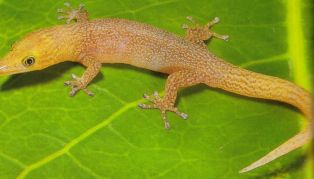 Ashy
Gecko- The Cuban Ashy Gecko is the largest of the North
American "dwarf geckos," although it only reaches 2.75 inches in total
length. The ashy geckos head, body, tail and legs are covered with a
network of tiny salt and pepper spots on a dark gray-brown background.
Like many geckos, the ashy gecko can be paler at night. Juveniles are
strikingly different, with bold black cross bands on the head and body
over a greenish gray color and a reddish tail. The ashy gecko has smooth
granular scales along the back, with a small spine-like scale over each
eye. Native to Cuban and Hispaniola, the ashy gecko has been known from
the Florida Keys since the 1920's. Reportedly common in early years, its
numbers have dwindled, and they are uncommon today. Ashy Geckos frequent
trees, buildings, vacant lots and stands of Australian pine. Ashy
Gecko- The Cuban Ashy Gecko is the largest of the North
American "dwarf geckos," although it only reaches 2.75 inches in total
length. The ashy geckos head, body, tail and legs are covered with a
network of tiny salt and pepper spots on a dark gray-brown background.
Like many geckos, the ashy gecko can be paler at night. Juveniles are
strikingly different, with bold black cross bands on the head and body
over a greenish gray color and a reddish tail. The ashy gecko has smooth
granular scales along the back, with a small spine-like scale over each
eye. Native to Cuban and Hispaniola, the ashy gecko has been known from
the Florida Keys since the 1920's. Reportedly common in early years, its
numbers have dwindled, and they are uncommon today. Ashy Geckos frequent
trees, buildings, vacant lots and stands of Australian pine.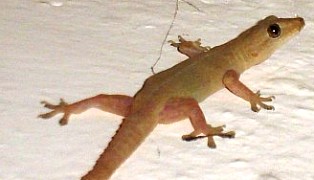 House
Gecko- Common House Geckos are widely distributed through
southern Asia, and are naturalized on islands and seaports throughout
much of the world’s warmer oceans. In Florida, they are known from a few
warehouse areas near Ft. Myers, Homestead, and Key West and Stock Island
on the lower Florida Keys. In Florida, it seems confined to the walls of
buildings. House geckos are largely insectivores, but adults will
consume spiders and other invertebrates, and occasionally juvenile
geckos as well. They are strongly territorial and can be quite vocal at
night, making a series of crisp, rapid chirps. They may make a squeaking
noise when captured. House
Gecko- Common House Geckos are widely distributed through
southern Asia, and are naturalized on islands and seaports throughout
much of the world’s warmer oceans. In Florida, they are known from a few
warehouse areas near Ft. Myers, Homestead, and Key West and Stock Island
on the lower Florida Keys. In Florida, it seems confined to the walls of
buildings. House geckos are largely insectivores, but adults will
consume spiders and other invertebrates, and occasionally juvenile
geckos as well. They are strongly territorial and can be quite vocal at
night, making a series of crisp, rapid chirps. They may make a squeaking
noise when captured.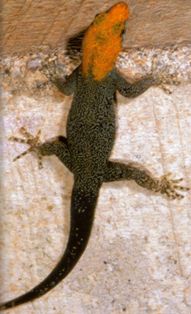 Yellow-Headed
Gecko- Yellow-headed Geckos are introduced to the Florida Keys
and the Miami area. They are native to the West Indies and Cuba and are
also found in Central and South America. They are common on buildings
and around rock and rubble piles. Males with their unmistakable
yellowish heads and dark blue to black bodies can often be seen clinging
to the underside of low horizontal branches. Females are mottled grayish
lizards often with a light collar line. Basking Yellow-headed Geckos are
dark brown to black, but fade to gray or blue-green (males) at cooling
nighttime temperatures. Yellow-headed Geckos have round pupils and lack
toepads. In both sexes, yellow-headed gecko tails have white tips. Adult
yellow headed geckos are only 2.5 - 3.5 inched long. Yellow-Headed
Gecko- Yellow-headed Geckos are introduced to the Florida Keys
and the Miami area. They are native to the West Indies and Cuba and are
also found in Central and South America. They are common on buildings
and around rock and rubble piles. Males with their unmistakable
yellowish heads and dark blue to black bodies can often be seen clinging
to the underside of low horizontal branches. Females are mottled grayish
lizards often with a light collar line. Basking Yellow-headed Geckos are
dark brown to black, but fade to gray or blue-green (males) at cooling
nighttime temperatures. Yellow-headed Geckos have round pupils and lack
toepads. In both sexes, yellow-headed gecko tails have white tips. Adult
yellow headed geckos are only 2.5 - 3.5 inched long.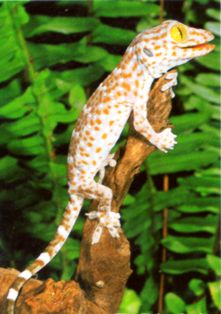 Tokay
Gecko- With a length of around 14 inches, tokay geckoes are one
of the largest geckoes alive today . The body of a tokay is cylindrical,
squat, and somewhat flattened on the upper side. The limbs are
well-defined and uniformly developed. The head is large and set off from
the neck, and they have large, prominent eyes with vertically-slit
pupils. The eyelids of these animals are fused together and transparent.
They also have a pineal body or “third eye” on the top of their head,
which is believed to coordinate their activity with light conditions.
The ears can be seen on the outside of the gecko as small holes on both
sides of the head. It is possible to see straight through the head of
these geckoes through their ears. Their toes that have fine setae on
them, allowing them to cling to vertical and over-hanging surfaces and
move at fast speeds. Tokay geckoes eat pests such as cockroaches and
locusts. In parts of Southeast Asia, tokay geckoes are regarded as
harbingers of luck, good fortune, and fertility. Tokay
Gecko- With a length of around 14 inches, tokay geckoes are one
of the largest geckoes alive today . The body of a tokay is cylindrical,
squat, and somewhat flattened on the upper side. The limbs are
well-defined and uniformly developed. The head is large and set off from
the neck, and they have large, prominent eyes with vertically-slit
pupils. The eyelids of these animals are fused together and transparent.
They also have a pineal body or “third eye” on the top of their head,
which is believed to coordinate their activity with light conditions.
The ears can be seen on the outside of the gecko as small holes on both
sides of the head. It is possible to see straight through the head of
these geckoes through their ears. Their toes that have fine setae on
them, allowing them to cling to vertical and over-hanging surfaces and
move at fast speeds. Tokay geckoes eat pests such as cockroaches and
locusts. In parts of Southeast Asia, tokay geckoes are regarded as
harbingers of luck, good fortune, and fertility.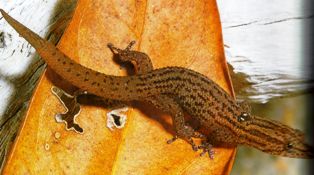 Reef
Gecko- The Florida Reef Gecko is a tiny round-bodied gecko with
relatively large, overlapping, and strongly keeled scales on the back.
Perhaps the smallest lizard in the United States, it is only 2 - 2.25
inches in total length. The reef geckos body and tail are covered with
dark spots on a brown background. Females have three broad longitudinal
dark stripes on the head, and may or may not have a pair of white, dark
edged "eye spots" on the shoulder. The body is covered with large
overlapping keeled scales. The only native gecko found east of the
Mississippi River, Florida Reef Geckos are known from the Dry Tortugas,
Florida Keys and extreme southeastern mainland Florida. These tiny
lizards are crepuscular, or active at dusk, when they can sometimes be
seen scurrying between holes, debris or other cover on the ground. They
feed on tiny insects and spiders. Reef
Gecko- The Florida Reef Gecko is a tiny round-bodied gecko with
relatively large, overlapping, and strongly keeled scales on the back.
Perhaps the smallest lizard in the United States, it is only 2 - 2.25
inches in total length. The reef geckos body and tail are covered with
dark spots on a brown background. Females have three broad longitudinal
dark stripes on the head, and may or may not have a pair of white, dark
edged "eye spots" on the shoulder. The body is covered with large
overlapping keeled scales. The only native gecko found east of the
Mississippi River, Florida Reef Geckos are known from the Dry Tortugas,
Florida Keys and extreme southeastern mainland Florida. These tiny
lizards are crepuscular, or active at dusk, when they can sometimes be
seen scurrying between holes, debris or other cover on the ground. They
feed on tiny insects and spiders. |
|
|
Advertise | Privacy Statement | Dog Encyclopedia | Video |Contact | Alaska Nature |
|